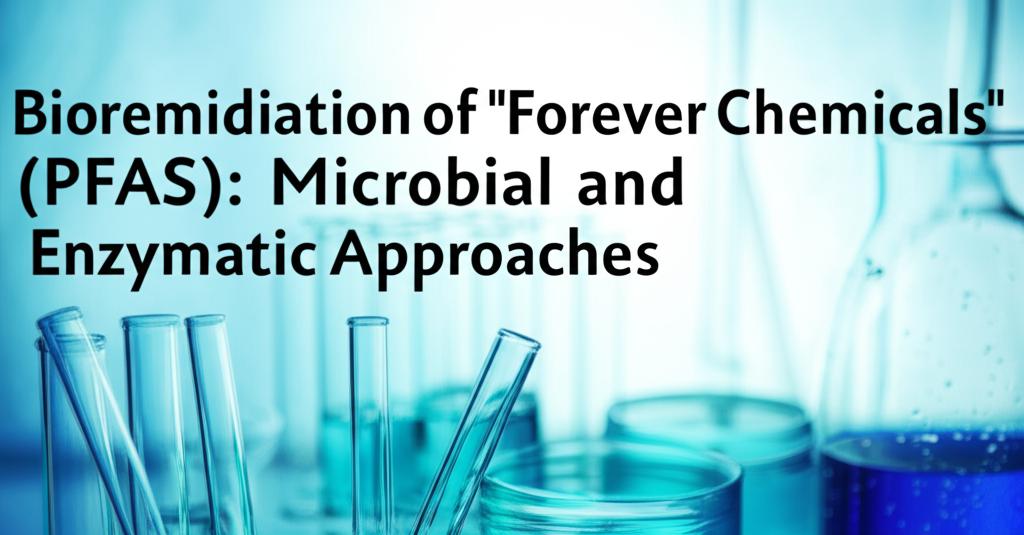Per- and polyfluoroalkyl substances (PFAS) are a large group of human-made chemicals used in a wide variety of industrial and consumer products due to their resistance to heat, water, and oil. This same resilience makes them incredibly persistent in the environment and in living organisms, earning them the nickname "forever chemicals." Their widespread presence in soil, water, and even human blood, coupled with links to various health problems including cancer and developmental issues, has spurred urgent research into effective remediation strategies. Bioremediation, which utilizes living organisms like microbes and their enzymes, offers a promising, environmentally friendly, and potentially cost-effective approach to tackle PFAS contamination.
Microbial Degradation of PFAS: Harnessing Nature's RecyclersScientists are increasingly exploring the potential of bacteria and fungi to break down these stubborn compounds. While historically, bioremediation of PFAS was considered challenging due to the strength of the carbon-fluorine bond (one of the strongest in organic chemistry), recent discoveries have shown that certain microorganisms possess the metabolic capabilities to transform, and in some cases, even defluorinate (remove fluorine atoms from) PFAS molecules.
- Bacterial Action: Several bacterial strains, particularly from the genus Pseudomonas and Acetobacterium, have demonstrated the ability to degrade specific types of PFAS. For instance, research from UC Riverside highlighted Acetobacterium species found in wastewater that can break down the carbon-fluorine bonds in unsaturated PFAS. Another study identified the bacterial strain Labrys portucalensis F11 as capable of metabolizing over 90% of perfluorooctane sulfonic acid (PFOS), a particularly persistent PFAS, over 100 days. This strain was also found to break down some of the toxic byproducts generated during the degradation process. The mechanisms often involve cometabolism, where the microbes break down PFAS in the presence of other food sources, or metabolic degradation, where PFAS themselves are used as a source of carbon or energy.
- Fungal Degradation: Fungi also play a role in PFAS bioremediation. Fungal biotransformation of PFAS is often an enzymatic oxidation or reduction process. While generally slower than bacterial biotransformation, some fungal cultures have shown promise.
- Microbial Consortia: Mixed microbial communities, often found in contaminated sites or wastewater treatment plants, can be more effective than single strains. These consortia can exhibit synergistic activities, where different microbes perform different steps in the degradation pathway.
- Phytoremediation and Microbial Synergy: Phytoremediation, the use of plants to remove pollutants, can be combined with microbial action. Plants can absorb PFAS, and then fungi or bacteria that colonize the plants or the surrounding soil can further break down these accumulated chemicals.
The key to microbial degradation lies in their enzymes – biological catalysts that facilitate chemical reactions. Researchers are working to identify and understand the specific enzymes responsible for PFAS transformation.
- Key Enzymes: Several types of enzymes are being investigated for their potential in PFAS degradation, including:
Dehalogenases: These enzymes specialize in removing halogen atoms (like fluorine) from organic molecules. Fluoroacetate dehalogenases (FAcDs) are a particular focus.
Laccases and Peroxidases: These enzymes are known for their ability to degrade a wide range of recalcitrant organic pollutants through oxidative processes.
Cytochrome P450 Enzymes: This large family of enzymes is involved in various metabolic processes, including the breakdown of foreign compounds.
Monooxygenases: Enzymes like alkane and butane monooxygenases are also being explored.
- Mechanism of Action: Enzymes can break the strong carbon-fluorine bonds through various reactions, including oxidation, reduction, and hydrolytic defluorination. For example, some bacteria use enzymes to cleave carbon-fluorine bonds, releasing fluoride ions. These microbes often have specialized mechanisms to pump the potentially toxic fluoride out of their cells.
- Enzyme Engineering: Understanding the structure and function of these enzymes opens the door to in silico (computational) design and enzyme engineering. Scientists aim to modify existing enzymes or design new ones to enhance their efficiency, broaden their specificity for different PFAS, and improve their stability under environmental conditions. This could lead to the development of enzyme-based bioreactors or direct enzymatic treatments for contaminated water and soil.
Despite promising advancements, the bioremediation of PFAS faces several hurdles:
- Slow Degradation Rates: Microbial degradation can be slow, especially for highly fluorinated compounds and large-scale contamination.
- Specificity: Many microbes and enzymes are effective against only certain types of PFAS. Given the thousands of different PFAS compounds, broader-spectrum solutions are needed.
- Incomplete Degradation and Toxic Byproducts: Sometimes, the degradation process is incomplete, leading to the formation of shorter-chain PFAS or other potentially harmful transformation products.
- Environmental Conditions: The effectiveness of bioremediation can be influenced by environmental factors like pH, temperature, and the presence of other contaminants.
- Bioavailability: PFAS can bind tightly to soil and sediment, making them less accessible to microbes.
Future research is focused on:
- Discovering Novel Microbes and Enzymes: Screening diverse environments for new microorganisms and enzymes with potent PFAS-degrading capabilities.
- Understanding Degradation Pathways: Elucidating the complete biochemical pathways involved in PFAS breakdown to ensure full detoxification and avoid harmful byproducts.
- Genetic and Enzyme Engineering: Enhancing the efficiency and applicability of microbial and enzymatic systems through advanced molecular techniques.
- Developing Combined Approaches: Integrating bioremediation with other remediation technologies (e.g., adsorption by activated carbon followed by microbial degradation) to create more effective and holistic solutions.
- Field-Scale Implementation: Moving beyond laboratory studies to develop and test robust in-situ bioremediation strategies for real-world contaminated sites. This includes approaches like bioaugmentation (adding specific microbes to contaminated environments) and stimulating indigenous microbial populations.
- Advanced Analytical Techniques: Employing sophisticated tools like metagenomics, transcriptomics, and metabolomics to better understand microbial communities and their functions in PFAS degradation.
The journey to find effective and sustainable solutions for "forever chemicals" is ongoing. Microbial and enzymatic bioremediation offers a beacon of hope, leveraging the power of nature to address this pervasive environmental challenge. Continued research and innovation in this field are critical to developing practical technologies that can help restore contaminated environments and protect human health.

